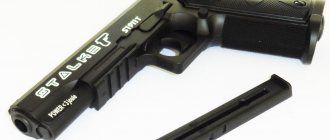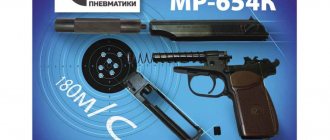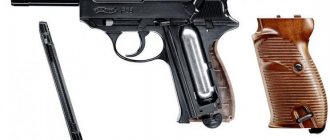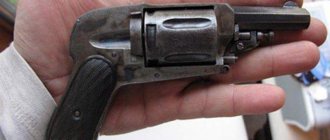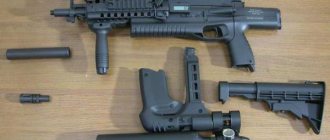| Smith & Wesson Model 29 | |
| S&W Model 29 with 8⅜ (top) and 4 (bottom) inch barrels | |
| Type | double action revolver |
| A country | USA USA |
| Production history | |
| Manufacturer | Smith & Wesson |
| Years of production | 1955 - present |
| Total issued | produced |
| Options | see options |
| Characteristics | |
| Weight, kg | 1.220, 1.332 or 1.460 (depending on barrel length - 4, 6½ and 8⅜ respectively[1]) |
| Barrel length, mm | 4, 6½ and 8⅜ inches[1] |
| Cartridge | .44 Russian, .44 Special or .44 Magnum[1] |
| Type of ammunition | 6-round drum |
| Smith & Wesson Model 29 at Wikimedia Commons | |
Smith & Wesson Model 29
- American double-action revolver chambered for .44 Magnum. One of the most popular Smith & Wesson revolvers. Often used in video games and films. At the time of launch in 1955 and for a long time after, it was positioned as the most powerful hand-held small arms in the world.[2].
Design
The weapon is a double-action revolver with the most powerful frame among Smith & Wesson revolvers due to the use of the powerful .44 Magnum cartridge. Simultaneous extraction of cartridges is carried out according to the most common principle among revolvers - the drum is tilted outside the frame, and then the shooter, by moving the extractor rod back, pushes the cartridges outside the chambers and weapons in general [1] [3].
Trunks
A revolver can use different barrels of the same caliber for different cartridges (since, for the reasons described below, the same revolver can use different cartridges in the same caliber). There are barrels with lengths of 4, 6½ and 8⅜ inches, and their length significantly affects the weight of the weapon itself (the difference in the weight of fully loaded revolvers of this model with barrels of 4 and 8⅜ inches is 240 grams [1]).
Caliber
The revolver is designed to use .44 Magnum smokeless powder cartridges. However, due to the immobility of the cartridges during shooting and the resulting lack of need to differentiate the strength of the mechanisms for feeding and extracting cartridges (such as the bolt and magazine), due to the design of revolvers in general, absolutely all .44 caliber cartridges with a length no less than the original can be used in this revolver, including black powder cartridges like .44 Russian or .44 Special[4]
Smith & Wesson pistols (USA)
The development and production of pistols since the founding of the company has long been uncharacteristic for. The company focused its main attention on the production of revolvers, in which it was very successful. The reason for this fact was, apparently, the first unsuccessful experience of entering the pistol market. Even before the outbreak of World War II, the company's engineers created several models of pistols of their own design for revolver cartridges of .32 and .35 calibers. However, as they say, business did not take off. The pistols turned out to be imperfect, rather difficult to manufacture and expensive, and were discontinued after the release of small batches. Thus, an automatic pistol of .35 caliber chambered in a special wafer cartridge was produced from 1913 to 1921 in a total quantity of only 8,000 copies; a .32 caliber pistol chambered in a standard ACP revolver cartridge was produced from 1924 to 1936 in a total quantity of 1,000 copies. For another company, such a quantity would be a godsend, but not for Smith & Wesson...
Several decades passed until gun developers revived the idea of creating a pistol. This time, the developers did not repeat previous mistakes with the choice of ammunition and decided to take the European pistol cartridge 9×19 “Parabellum”, which had by that time become classic (and standard for NATO countries), as the basis for future development.
Pistol "Smith & Wesson" 59
In fact, the first Smith & Wesson pistol in many decades was a .22 caliber automatic target pistol, released in 1951. It was designated Smith & Wesson 41 and had fairly decent accuracy. The weapon was such a great success that it is still produced with minor changes - more than half a century later. The success of this weapon pushed the company to the next step.
Since 1954, the 9 mm Smith & Wesson 39 (“Model 39”) pistol was produced, which was assessed at that time as very promising and became the first commercially successful combat pistol. The company’s engineers collected in this model all the ideas that were advanced at that time, as they say, “from the world.” The Model 39 pistol was basically the same design as the Browning Hi Power (even had a similar design). The safety lever was taken from the German “Walther”, located in the rear of the bolt. The Parabellum cartridge has already been mentioned. During testing, the weapon demonstrated impressive characteristics in terms of reliability and accuracy of combat. The pistol was favorably received by the US military department and put into service with the US Navy and special forces.
Read: MP5 submachine gun - the most famous “German”
In 1970, the Model 39 pistol was modernized and began to be produced under the designation “Smith & Wesson” 59. The modernization affected primarily the appearance of the weapon, as well as the pistol magazine. Model 59 received a new design due to the straightened rear end of the handle, which provided greater ease of handling the weapon. But the most important improvement is the magazine capacity of 14 rounds, which has almost doubled compared to the 39th model, which was equipped with an 8-round magazine.
Smith & Wesson SW 99 pistols
After the introduction of a single numbering of pistols, modifications of models 39 and 59 “proliferated” to an indecent number. The initial numbers in the name of the modification indicated the material from which the weapon was made: 4 - with an aluminum handle, 5 - entirely made of steel, 6 - made of stainless steel. Accordingly, models were produced that received the following designations: 439, 539, 639, 459, 559, 659. However, these were not just the same models, just made of different materials.
Each modification had minor but very useful differences. For example, variants 439 and 459 had more advanced sights, a more reliable ejector, as well as a new firing pin safety connected to the trigger. The same goes for other models.
Standing somewhat apart is a shortened modification of the Model 459, designated “Smith & Wesson” 469. This 9 mm pistol was developed in 1983 in accordance with the requirements of the US Air Force and was distinguished by a shortened frame made of lightweight alloy, the absence of an external safety, and a reverse-curved trigger guard. hook, the absence of a shank on the trigger, a polished outer surface and a different design of the magazine, the protrusion of the cover of which served as a rest for the shooter’s little finger. All these features met the requirements for safe handling.
Pistol "Smith & Wesson" TSW
In addition, since 1985, based on the 439th model, the 645 American .38 caliber model was produced, which differed from its prototype in its greater mass, longer barrel, and more advanced safety mechanism. This version was equipped with three fuses: a standard flag fuse on the bolt-casing (locks the firing pin), a frame fuse (blocks the firing pin until the last stage of pressing the trigger), and a magazine safety (locks the hammer and trigger when the magazine is missing). Another useful innovation worth noting is the numbers stamped on the magazine body, corresponding to the number of cartridges remaining in it. Currently, further modifications of this weapon are being produced - models 647 and 648.
From 1961 to the present, it has produced a very advanced target pistol, the Smith & Wesson 52 caliber .38, based on the Model 39 pistol. In short, by 1990 it had created a whole range of automatic pistols that were in no way inferior to its best revolvers, and thus gained a foothold in a new market.
Read: M113 armored personnel carrier - the most popular armored vehicle
By 1989, production of almost all model 39 and 59 pistols (as well as their modifications) was discontinued. This was apparently explained by purely marketing considerations, since these pistols had good commercial success on the market. But the time has come to change the range of weapons. In addition, the command of the US Army announced a competition for the production of a pistol capable of replacing the Colt M 1911. It so happened that among the American ones it was essentially the only one that managed to compete on equal terms with the excellent Italian models. As you know, the Beretta M 92 model won the competition, and announced the next step - the creation of a new series of pistols, called the “third generation”. Weapons of this particular series, replacing models 39 and 59 (with the exception of model 52), are still produced today.
Structurally, all pistols in this series are nothing more than an improved in detail, but unchanged in principle, version of the successful 59 series pistol.
Among the important changes that distinguish the third series from previous developments are:
— improved trigger mechanism with a softer force on the trigger; — improved sights with three aiming points; — a modified shape of the ammunition shaft, speeding up the replacement of the magazine; — a mandatory triple safety system for the 645 model pistol; - the emergence of models for ammunition other than 9x19 “Parabellum”, which for a long time was standard for “Smith & Wesson”.
The third generation Smith & Wesson pistols include the following models:
- the basic 9 mm Smith & Wesson model 5900, including the 5903 model with a lightweight alloy frame and a stainless steel slide-casing; 5904 with a lightweight alloy frame, carbon steel slide and stainless steel barrel, and 5906, made entirely of stainless steel; - lightweight 9 mm Smith & Wesson model 3900, including models 3903, 3904 and 3906 (same materials as 5903, 5904 and 5906), as well as models 3913 with a lightweight frame and stainless steel slide-casing and 3914 with frame made of lightweight alloy and slide-casing made of carbon steel; - compact 9 mm model “Smith & Wesson” 6900, which is an even shorter version of the 3900 model, but with a magazine capacity increased to 12 rounds. This series includes models 6903, 6904, 6906 (same materials as 5903, 5904 and 5906), 6913 and 6914 (same materials as 3913 and 3914); - Smith & Wesson 1000 model chambered for the popular 10 mm Auto cartridge. In addition to the standard versions 1003, 1004, 1006, 1013 and 1014, models 1066 with a shortened barrel and 1076, designed specifically for the FBI, are available, equipped with a safety release lever instead of a safety lever; - Smith & Wesson 4000, a variant of the 5900 chambered for the new .40 Smith & Wesson (10mm) ammunition, designed to compete with the 10mm Auto cartridge while being the same size as cartridge 9x19 “Parabellum” (materials are the same as the 5900 series); - Smith & Wesson 4500 model chambered for the .45 ACP cartridge, which is not inferior to its position. This is a heavier and more massive weapon. The 4506 is made entirely of stainless steel, the 4516 is a compact stainless steel variant, and the 4566 is a longer barrel variant of the 4506.
Read: Grumman S-2 “Tracker” - submarine hunter
Currently, third-generation Smith & Wesson pistols are very popular in the civilian market. In addition, they are purchased in large quantities by US government agencies and police departments. Therefore, the company itself is currently inclined to abandon the outdated name “third generation”, replacing it with the abbreviation TSW (Tactical Series Pistols - tactical series pistols).
Finally, the latest development of Smith & Wesson is a completely non-standard pistol for it, designated SW 99. One glance at this weapon is enough to recognize it as the Walther P 99 pistol, which was developed by the German company in the mid-1990s. 's However, she herself makes no secret of this, positioning this weapon as a variant of the P 99, modified for the use of .40 Smith & Wesson cartridges (however, there is a modification for the European 9x19 Parabellum cartridge) and adapted according to the American legislation limiting the magazine capacity of weapons on sale to 10 rounds. In 2003, the SW 99 series was expanded: a variant chambered for the unchanged .45 ACP cartridge appeared.
You might be interested:
- Smith & Wesson revolver design 29
- Smith & Wesson 10 revolver design
- Revolvers "Dan Wesson" (USA)
- Revolvers "Smith & Wesson" (USA)
- Revolvers "Astra" (Spain)
- Revolvers "Taurus" (Brazil)
Subscribe to
our channel in Yandex.Zen
Options
The pistols are produced in two versions chambered for different cartridges: the SD9 uses the traditional European 9 × 19 mm Parabellum cartridge, and the SD40 uses the relatively new American .40 S&W. These models are characterized by various stores of both regular capacity (std cap.) and reduced capacity (low cap.)[4].
| Model | Barrel length in inches | Cartridge | Magazine capacity | Width and length in inches | Weight without magazine in ounces | Color |
| SD9 VE std cap. | 4.0 | 9×19mm Parabellum | 16 | 1.29 x 7.2 | 22.7 | two-tone finish |
| SD9 VE low cap. | 4.0 | 9×19mm Parabellum | 10 | 1.29 x 7.2 | 22.7 | two-tone finish |
| SD40 VE std cap. | 4.0 | .40 S&W | 14 | 1.29 x 7.2 | 22.7 | two-tone finish |
| SD40 VE low cap. | 4.0 | .40 S&W | 10 | 1.29 x 7.2 | 22.7 | two-tone finish |
